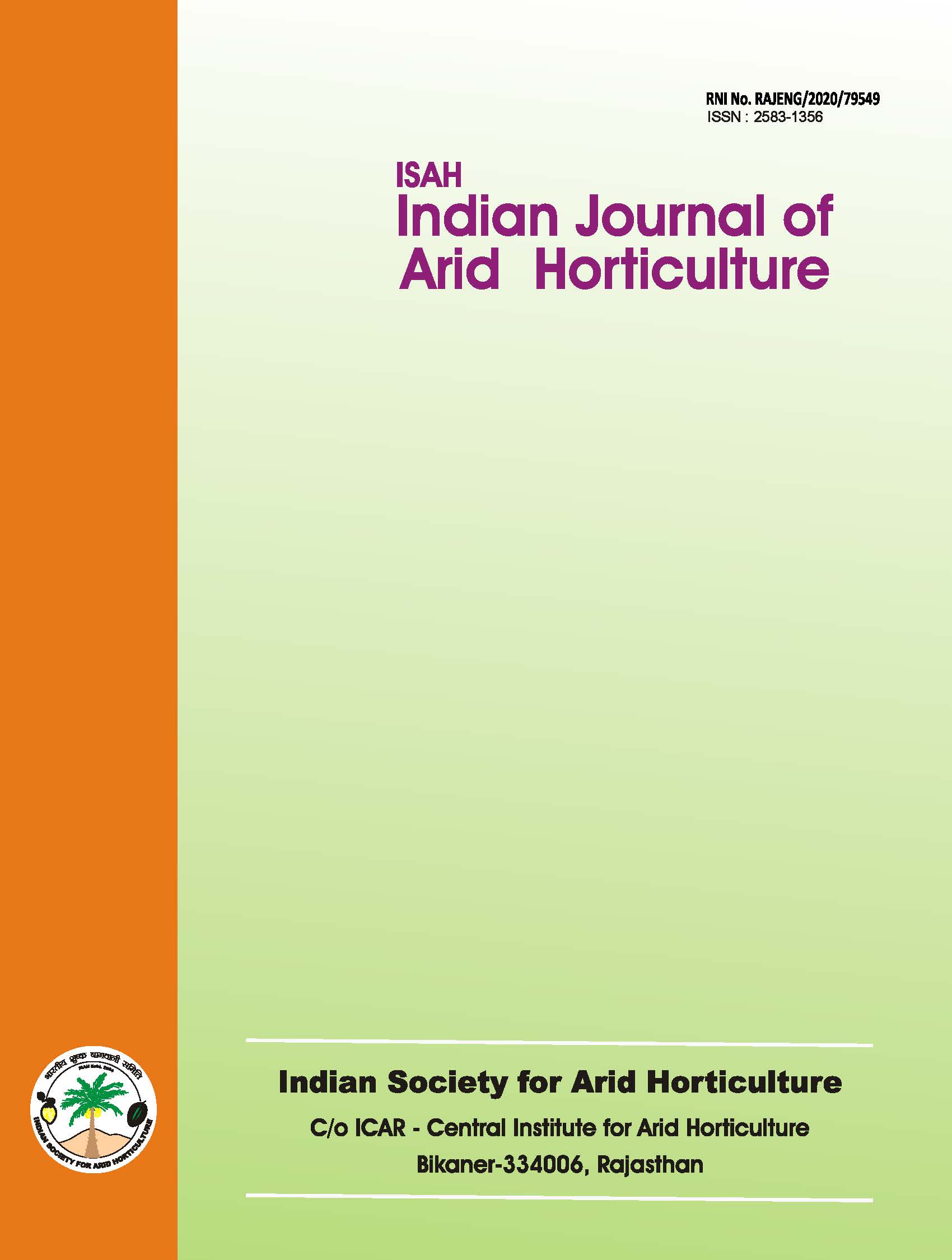Performance of fruit trees (drip irrigation) and intercrops (rainfed) under agri-horti system in arid Western Rajasthan.
Keywords:
Agri-horti system, drip irrigation, intercropping, Western RajasthanAbstract
Moth bean (Vigna aconitifolia), cluster bean (Cyamopsis tetragonoloba), and sonamukhi (Cassia angustifolia) were grown as intercrops under an agri-horti-silvi system with 7-year-old plantations of citrus (Citrus aurantifolia), bael (Aegle marmelos), and gonda (Cordia myxa) at the research farm of Central Arid Zone Research Institute, Regional Research Station, Bikaner, during two consecutive years of 2008 and 2009. The highest seed and stover yield of moth bean (460 & 1881 kg/ha in 2008 and 320 & 1304 kg/ha in 2009) and cluster bean (623 & 2146 kg/ha in 2008 and 533 & 1838 kg/ha in 2009) as well as the leaf and seed yield of sonamukhi (323 & 53 kg/ha in 2008 and 415 & 80 kg/ha in 2009) was recorded in intercropping with citrus. Among the different levels of irrigation applied to fruit trees, irrigation at 80% of potential crop evapotranspiration (ETc) gave the highest yield and water use efficiency in all the crops, while the lowest was recorded at 40% ETc. It was also observed that cluster bean intercropped with citrus recorded the highest water use efficiency (WUE) (3.76 kg/ha/mm).Downloads
References
Anderson, S.H., Udawatta, R.P., Scobi, T., & Garrett, H.E. (2009). Soil water content and infiltration in agroforestry buffer strips. Agroforestry Systems, 75, 5-16.
Beniwal, R.K., Soni, M.L., & Yadava, N.D. (2008). Soil moisture extraction pattern of arid zone trees under agro-horti-silvi system in northwestern Rajasthan. In: Natural Resource Management for Sustainable Development in Western India (Eds. S.N. Patil, R.K. Singh, Ashok Kumar, A.K. Pandiyal, Shakir Ali, Somsundaran, V.K. Seth), 197-198. Allied Publishers Pvt. Ltd., New Delhi.
Chadha, K.L. (2002). Diversification in horticulture for food, nutrition, and economic security. Indian Journal of Horticulture, 52, 137-140.
Fadl, K.E.M., & Sheikh, S.E.E. (2010). Effect of Acacia senegal on growth and yield of groundnut, sesame, and roselle in an agroforestry system in North Kordofan state, Sudan. Agroforestry Systems, 78, 243-252.
FAO. (2013). Advancing Agroforestry on the Policy Agenda. Agroforestry Working Paper no. 1. Food and Agriculture Organization of the United Nations, Rome.
Gómez, K.A., & Gómez, A.A. (1984). Statistical Procedures for Agricultural Research (2nd Ed.). John Wiley and Sons, New York.
Hany, T., Ashtem, M.S., Montagnini, F., & Martinez, C. (2010). Using agroforestry to improve soil fertility: Effects of intercropping on Ilex paraguariensis (yerba mate) plantations with Araucaria angustifolia. Agroforestry Systems, 80, 399-409.
Jianbo, L. (2006). Energy balance and economic benefits of two agroforestry systems in northern and southern China. Agriculture, Ecosystems & Environment, 116, 255-262.
Kaushik, N., Kaushik, R.A., Kumar, S., Sharma, K.D., & Ohankha, O.P. (2011). Comparative performance of some agro-silvi-horti systems with drip irrigation under arid regions. Indian Journal of Horticulture, 68(1), 12-17.
Kaushik, N., Kumari, S., Singh, S., & Kaushik, J.C. (2014). Productivity and economics of different agro-silvi-horti systems under drip irrigation. Indian Journal of Agricultural Sciences, 84(10), 1166-1171.
Kaushik, N., & Kumar, V. (2003). Khejri (Prosopis cineraria)-based agroforestry system for arid Haryana, India. Journal of Arid Environments, 55, 433-440.
Ndayambaje, J., & Molueo, G. (2011). Fuelwood demand and supply in Rwanda and the role of agroforestry. Agroforestry Systems, 83, 303-311.
Pareek, O.P. (1999). Dryland horticulture. In: Fifty Years of Arid Zone Research in India (Eds. A.S. Faroda & Manjit Singh), 475-484. Central Arid Zone Research Institute, Jodhpur, Rajasthan.
Purohit, R.C., Alafaa, S.S., & Miller, R.P. (2011). Islands of fertility: Soil improvement under indigenous home gardens in the savannas of Roraima, Brazil. Agroforestry Systems, 81, 235-247.
Singh, B., Bishnoi, M., & Baloch, M.R. (2012). Tree growth and wheat yield in agro-horti-silvi system in the arid region of Rajasthan. Indian Forester, 138(8), 726-732.
Singh, G. (2010). Rainfall dependent competition affecting productivity of Vigna radiata in Horti-wickia binata agroforestry in Indian desert. Indian Forester, 136, 3013-3015.
Singh, R.S., Gupta, J.P., Rao, A.S., & Sharma, A.K. (2003). Micro-climatic quantification and drought impacts on productivity of green gram under different cropping systems of arid zones. In: Human Impact on Desert Environment (Eds. P. Narajan, S. Kalhju, A. Kar, M.P. Singh, & Praveen Kumar), 74-80. Scientific Publishers, Jodhpur, India.
Singh, R.S., & Kumar, A. (1993). Agro-horticulture systems under semi-arid conditions. Agroforestry News, 5(1), 3-5.
Vallejo, V.E., Arheli, Z., Teran, W., Lorenz, N., Dick, R.P., & Roldan, F. (2012). Effect of land management and Prosopis juliflora (Sw.) DC trees on soil microbial community and enzymatic activities in intensive silvopastoral systems of Colombia. Agriculture, Ecosystems & Environment, 150, 139-148.
Yadav, R.S., Yadav, B.L., & Chhipa, B.R. (2008). Litter dynamics and soil properties under different tree species in a semi-arid region of Rajasthan, India. Agroforestry Systems, 73, 1-12.

